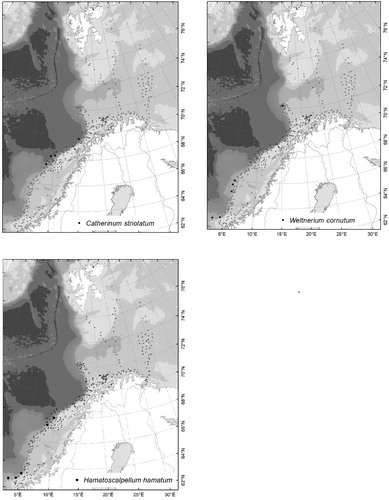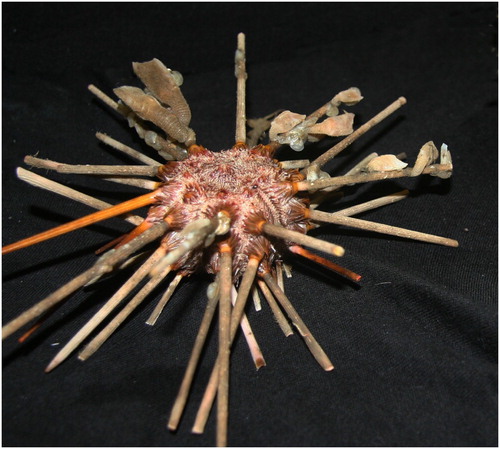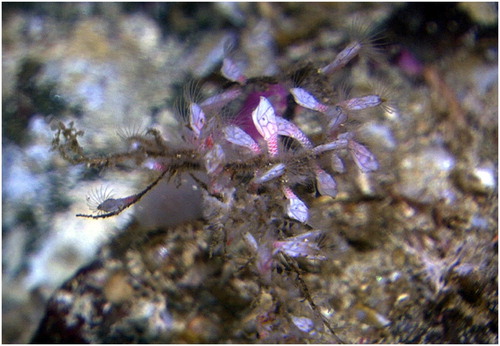ABSTRACT
We describe the distribution and habitats of Amigdoscalpellum hispidum, Weltnerium stroemii, Scalpellum scalpellum, Weltnerium cornutum, Catherinum striolatum, Weltnerium nymphocola and Hamatoscalpellum hamatum in the Norwegian and Barents Seas, and their morphology. These are seven of the eight scalpellid species recorded in the area. Expeditions from 2006 to 2018 of the MAREANO (Marine areal database for Norwegian waters) programme have provided a comprehensive collection of Scalpellidae that can contribute to our knowledge of their distribution. The collections were from 335 localities in 40–2300 m depth. Of the 1406 specimens collected, 1396 were collected by beam trawl and 37 were from grabs. Patchy distributions and the association of species with other organisms (e.g. hydroids and gorgonian corals) can explain the low abundance in grabs compared with beam trawls, the latter covering larger areas and mixed sediments better. Weltnerium stroemii was the most abundant species and had the largest depth and temperature range, followed by A. hispidum and W. nymphocola. Species were assigned into three geographic groups based on their depth distribution. Shelf species: W. stroemii, S. scalpellum and A. hispidum occurring mainly shallower than 400 m in water temperatures >4°C; Upper slope species: W. nymphocola, W. cornutum and H. hamatum, found mainly between 600–1000 m in temperatures from 4 to 0°C; Lower slope species: C. striolatum occurring below 1500 m in temperatures <0°C. The species C. striolatum and W. cornutum are new to the Norwegian fauna and future deep-sea exploration will probably discover further scalpellid species.
Introduction
During 2006–18 the Norwegian programme MAREANO (Marine areal database for Norwegian waters) collected seafloor samples from 335 stations () to document benthic species diversity in the Norwegian EEZ. MAREANO is a national seafloor mapping initiative with a focus on benthic habitats and species diversity. This large collection has contributed to new information on the distribution and habitat requirements of several taxonomic groups (e.g. Ringvold et al. Citation2014; Buhl-Mortensen et al. Citation2016; Byrkjedal et al. Citation2016; Oug et al. Citation2017; Johansen and Vader Citation2020). In this study, we provide new information on the scalpellid cirripeds present in the study area.
Figure 1. The position of the 335 sampling stations covered by the MAREANO programme from 2006 to 2018, from which the material of Scalpellidae cirripeds was collected. + are stations without records of scalpellids and black dots indicate that scalpellids were recorded.
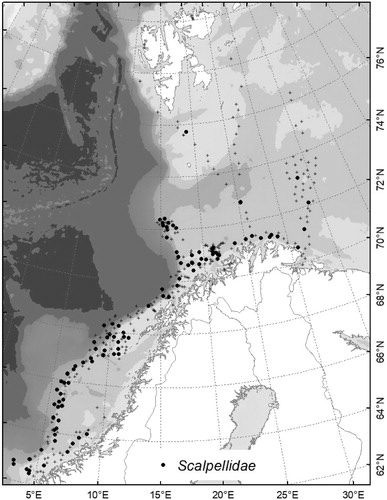
Scalpellid cirripeds are attached to the substrate at the base of the peduncle and mainly use other organisms as substratum, e.g. hydrozoans, bryozoans, echinoderms and corals (Buhl-Mortensen and Mortensen Citation2005; Buhl-Mortensen and Høeg Citation2006; Pica et al. Citation2015). Their body and inner organs are hidden inside the capitulum and only the ‘cirri’, appendages used for filter feeding, are visible outside. The capitulum is covered by protective calcified valves that are the main morphological character used for identification (). Most scalpellid species (∼75%) have separate sexes, the rest are hermaphrodites (Buhl-Mortensen and Høeg Citation2006, Citation2013). The specimens that are recorded are for most species females, since the much smaller and morphologically reduced male (‘dwarf male’) is attached to the receptacle inside the female. The species that are hermaphrodite can in addition have smaller complementary males.
Figure 2. For species identification of Scalpellidae cirripeds the valves on capitulum (upper part of the stalked cirriped) and the stalk (peduncle) that attaches the specimen to the preferred host or substratum are important. The names of the valves on capitulum are indicated by letters superimposed on the capitulum of Weltnerium stroemii: rostrum (r), latus rostrale (lr), latus inframedium (li), latus carinale (lc), scutum (sc), upper latur (ul): carina (ca), tergum (t).
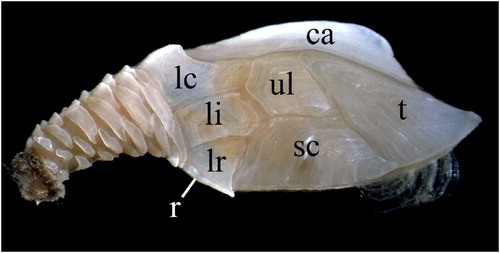
A main revision of Scalpellidae cirripeds was made by Zevina (Citation1978a, Citation1978b, Citation1981) and genus assignments were changed for three of the studied species by Young (Citation2007) and Gale (Citation2016). At present there are more than 30 genera and 330 species; eight of these are found in the study area (Nilsson-Cantell Citation1978) of which seven are covered in this study: Amigdoscalpellum hispidum, Weltnerium stroemii, Scalpellum scalpellum, Weltnerium cornutum, Catherinum striolatum, Weltnerium nymphocola and Hamatoscalpellum hamatum.
The species were identified based on morphology and arrangement of valves on capitulum and scales on peduncle. Their external morphology is presented in A–G, and the main differences are listed in what follows: Weltnerium stroemii M. Sars, 1859, is characterized by having umbo of carina not apical, a feature it shares with S. scalpellum Linnaeus, 1767, which is a large species with a maximum total length of 50 mm (Nilsson-Cantell Citation1978). It can be distinguished from W. stroemii by having the umbo of scutum not apical. Amigdoscalpellum hispidum G.O. Sars, 1890, is easily recognized by having a rather hairy appearance, and the umbo of carina is placed at apex, with latus inframedium small and triangular. Weltnerium nymphocola Hoek, 1833, also has umbo of carina apically placed, and a large latus inframedium. In C. striolatum G.O. Sars, 1877, the valves appear striated, it has a small latus inframedium, narrow in the middle and thus shaped like an hourglass, with the upper part being the widest. Weltnerium cornutum G.O. Sars, 1879, is characterized by having a distinct ‘horn’ projecting out from latus carinale, and the valves are strongly calcified with a striated structure, particularly in latus inframedium and latus carinale. Hamatoscalpellum hamatum G.O. Sars, 1879, is distinguished from the other species by having both latus carinale and latus rostrale projected outwards, and umbo of carina is apical. The edges of valves are not distinct, and the scales of the peduncle are small.
Figure 3. The morphology of the seven Scalpellidae species that are found in the Mareano material from Norwegian waters. A: Weltnerium stroemii; B: Scalpellum scalpellum; C: Amigdoscalpellum hispidum; D: Weltnerium nymphocola; E: Catherinum striolatum; F: Weltnerium cornutum; G: Hamatoscalpellum hamatum. Scale bar = 1 mm.

Former records of scalpellids in the study area are scarce and are mainly restricted to the deep sea (Nilsson-Cantell Citation1978; Brattegard and Holte Citation1997; Bakken and Moen Citation2004). The goal of the present study is to substantially increase our knowledge of their occurrences and habitat requirements together with photo documentation of their external morphology.
Materials and methods
The scalpellid material was collected at 335 localities in the period from 2006–18 by the MAREANO programme (). Of the 335 beam trawl collections, 106 contained scalpellids. Only 19 of the 780 grab shuts from the continental shelf and slope of Norway from 62°N to the Barents Sea 80°N contained scalpellids. The beam trawl, 2 m wide and with a mesh size of 4 mm, was towed at 1.5 knots for 5 min, collecting the fauna from about 300 m2 of seafloor area. For large beam trawl samples (>200 l) subsampling was conducted on deck before sieving and typically 25–50% of these samples were sorted in the laboratory. Two van Veen grabs have been used in the MAREANO programme dependent on depth, sampling 0.1 or 0.25 m2 of seafloor and 5 or 2 samples were conducted at each station to cover 0.5 m2. A test comparing the fauna collected with van Veen grabs 0.1 or 0.25 m2 (Holte and Buhl-Mortensen Citation2020) showed that the fauna composition was comparable but the larger sampler was more efficient. Samples were first stored in 4% buffered formaldehyde, then after sorting the material was transferred to 70% alcohol. The identification key used was Nilsson-Cantell (Citation1978). Biological data were logged together with data on position, depth, temperature and salinity in the database Marbunn (www.mareano.no). The identified samples are housed at the Bergen Museum for long-term storage.
The external morphology of the seven species present in the study area were documented photographically using a Canon 6D connected with EOS Utility and a dissection microscope connected with QCapture.
The plots and statistical analysis of environmental information were presented using statistics available in Excel, and figures on distribution were produced using ESRI 2020. ArcGIS Desktop: Version 10.8. (Environmental Systems Research Institute, Redlands, CA).
Results
A total of 1406 specimens were collected, 1396 were from 106 beam trawl samples out of 335, and 37 specimens were from 19 out of 780 grabs. Thus, the beam trawl was by far the most efficient gear to collect scalpellids. Six per cent of the collected Scalpellidae was not identified to species level due to sample quality.
Weltnerium stroemii was the most common species, contributing 43% to the total, followed by A. hispidum (22%) and W. nymphocola (21%) (). The material contained 316 specimens of A. hispidum, a species for which only a few specimens have been reported from the study area before.
Table 1. Number of individuals recorded by gear for the seven Scalpelidae species in the MAREANO material collected from 2006 to 2018.
As numbers of observed specimens for most species were low, numbers per area sampled were not estimated. Scalpellum scalpellum, a common shallow-water species, was recorded only at six locations and not below 210 m. The relatively rare species W. cornutum, H. hamatum and C. striolatum occurred mainly below 600 m and are deep-sea species with few earlier observations, the latter only occurring in arctic waters >1500 m.
Depth and temperature: The depth and bottom temperature range for each of the seven species is shown in and . The seven species can be divided into three groups based on depth, temperature and landscape of occurrence: a Shelf group consisting of S. scalpellum, A. hispidumand W. stroemii having their main occurrence shallower than 400 m and temperatures above 4°C;– an Upper slope group of species found mainly between 600–1000 m at a temperature range from 4 to 0°C consisting of W. nymphocola, W. cornutum and H. hamatum; – a Lower slope species occurring >1500 m at negative temperatures, V. striolatum.
Figure 4. A box plot of the depth distribution for the seven species of Scalpellidae cirripeds recorded in the MAREANO material from 2006 to 2018. The box shows the second and third quartile (50% of the measurements) with the median as the horizontal line, and the vertical line indicating the maximum and minimum values. Observations are shown as circles including outliers. Shelf slope break and upper and lower shelf are marked with a dotted horizontal line.
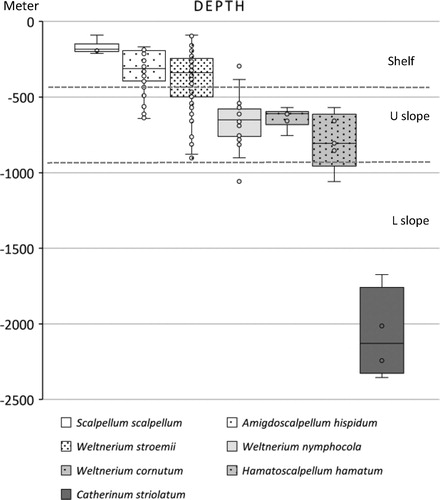
Figure 5. A box plot of the temperature distribution for the seven species of Scalpellidae cirripeds recorded in the MAREANO material from 2006 to 2018. The box shows the second and third quartile (50% of the measurements) with the median as the horizontal line, and the vertical line indicates the maximum and minimum values. Observations are indicated with circles including outliers. Dotted horizontal line marks the depth of the shelf-slope break and the border between upper and lower shelf below which the temperature is <0°C.
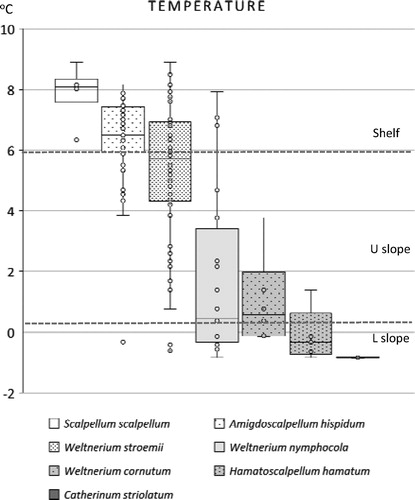
The geographic distribution of the seven species is presented in . For S. scalpellum the six sites of occurrence were distributed from 62°22′ to 70°59′N, at a mean depth of 171 m. On one occasion specimens were collected attached to the spines of the echinoid Cidaris cidaris (). The many records of W. stroemii showed a wide distribution, ranging from 62°22′ to 75°43′N and the species was common on the shelf and it was also present in the Barents Sea, mean depth of 369 m. Visual mapping conducted by MAREANO has frequently documented this species attached to hydroids (). Also A. hispidum had a wide distribution on the shelf ranging from 63°23′ to 72°25′N with the deepest observation at 641 m and a mean depth shallower than W. stroemii. Weltnerium nymphocola had a wide distribution, from 62°45′ to 72°25′N, occurring mainly on the upper slope and the deepest station was 1057 m. The relatively rare species C. striolatum was recorded from 67°35′ to 69°44′N, all locations were below 1600 m. Weltnerium cornutum occurred on six stations mainly south of 66°N at 569 −754 m, and the endemic species H. hamatum was recorded from five stations in the southern part of the investigation area at depths of between 600–1100 m.
Figure 6. The geographic distribution of the Scalpellidae species: Weltnerium stroemii, Scalpellum scalpellum, Amigdoscalpellum hispidum, Weltnerium nymphocola based on samples collected by the MAREANO programme from 2006 to 2018. ● marks localities with occurrence and + are without observations of the species.
Discussion
Of the 1406 specimens 1396 were from 106 beam trawl samples, 32% of the total number of samples, and 37 specimens were from 19 grab samples, 2% of the total number of samples. Clearly the beam trawl covers a larger area per sample than the grab, this however cannot explain the very low records in the latter gear. Grabs are designed to work mainly on soft sediments and will not function well on mixed substrates (Holte & Buhl-Mortensen Citation2020). Scalpellidae cirripes are attached mainly to other organisms that are sessile and occur on mixed or hard substrates, this is likely the reason for the very low abundance in grab-samples and is also a strong indication that soft sediments are not a preferred habitat.
Eight species belonging to the families Scalpellidae are recorded in the Nordic seas (Greenland – Iceland – North Sea – Norwegian Sea – The Barents Sea to the Polar Sea) (Nilsson-Cantell Citation1978). With the exception of Scillaelepas gemma (Aurivillus, 1894) of which one specimen has been reported from 1800 m depth west of Iceland, all the other species were recorded in this study.
Species lists have been made for the coast of Norway (Brattegard and Holte Citation1997) and the Svalbard region (Gulliksen et al. Citation1999) that provide information on geographic distribution of cirripeds. The Battergard and Holte (Citation1997) list does not include C. striolatum, W. cornutum and W. nymphocola that were recorded in the present study with 8, 39 and 297 specimens, respectively. Weltnerium nymphocola has been recorded west and north of Svalbard (Nilson-Cantell Citation1978; Gulliksen et al. Citation1999) and Bakken and Moen (Citation2004) reported two specimens collected from 868–880 m on the Norwegian continental slope, but they had no observations of C. striolatum or W. cornutum. Thus, all these species have been poorly recorded in earlier studies indicating that they are rare, however, they occur mainly at depths that have been poorly sampled. These three scalpellid species are, together with H. hamatum (only having few earlier records and 11 specimens in this study) viewed by Nilson-Cantell (Citation1978) as a group that is characteristic and endemic of the bathyal and Arctic abyssal zone. This corresponds with our observations of a mean depth and temperature for these species of >600 m and <2°C. The rare encountering of these deep-sea species may in addition to poor sampling be due to their association to specific hosts in mixed and hard substratum habitats that are not easily sampled, e.g. hydroidsand gorgonian corals (Buhl-Mortensen and Høeg Citation2006). Weltnerium nymphocola is found attached to the legs of the pycnogonid Boreonymphon robustum (Buhl-Mortensen and Høeg Citation2013) that has a very narrow distribution in the area (Ringvol et al. Citation2014). At these depths and temperatures growth rates are generally slow, as indicated by the growth measurement of two deep-sea scalpellid barnacles reported by Yusa et al. (Citation2018).
With increased effort to document deep-sea communities, like the MAREANO initiative, our knowledge will increase substantially and formerly rare species will change status and their distribution and habitat will be based on sounder grounds while at the same time many new species will be added to the local fauna list.
An overview of scientific names with synonyms, depth and temperature ranges, and biological data is listed in . Both geographically, and with respect to the depth and temperature preferences, the findings from Mareano contributes with new data. Weltnerium stroemii which is known to have wide distribution was the only species occurring in the eastern and northern part of the Barents Sea. This is in accordance with observations from Nilsson-Cantell (Citation1978), where the coast of Murman and western Svalbard are mentioned as part of the distribution area. Further, W. stroemii is said to prefer positive temperatures. The species is reported with records as far north as Bear Island and Svalbard (not specified) in Gulliksen et al. (Citation1999). Scalpellum scalpellum was not found in the Barents Sea north of 71°N, and the six stations were all from water with a temperature >6°C, and not deeper than 210 m. This species is frequently recorded off the south and west coasts of Britain and Ireland, as well as in the Mediterranean Sea and along the coast of Norway (Nilsson-Cantell Citation1978; Hosie Citation2008). Amigdoscalpellum hispidum was the second most abundant Scalpellidae species present in the material and recorded from 40 localities north to 72°25′N. Nilsson-Cantell (Citation1978) reported only a few records of A. hispidum from the coast of Norway together with a temperature of 3.3–3.8°C, and a single specimen was reported by Bakke and Moen (Citation2004). The present data show that the species is relatively common and occurs mainly between 4 and 8°C. Weltnerium nymphocola seemed to have a similar geographic distribution to A. hispidum, but it also occurred farther out on the continental slope and in deeper water at temperatures below zero. The temperatures ranged from almost −1–8°C, so the species should be considered quite eurythermal. Nilsson-Cantell (Citation1978) claims it is an arctic species, also found in the boreal parts of the Atlantic, being stenothermal and preferring cold water. It has been found west and north of Svalbard by Gulliksen et al. (Citation1999). Bakken and Moen (Citation2004) made for the first time a record of W. nymphocola on the shelf slope of the Norwegian coastline at 69°24′N, 15°15′E. Together with H. hamatum, W. nymphocola is considered a common inhabitant of the Barents and Norwegian Seas benthos and is also found associated with chemobiotic communities (Poltarukha Citation2011). Weltnerium cornutum occurred on six stations, most of them south of 66°N, at low temperatures. The data are too few to establish the geographic preferences, but W. cornutum is considered an east arctic species in Nilsson-Cantell (Citation1978). It was recorded during the investigations by Bakken and Moen (Citation2004) and was described as ‘rarely found’. It is not mentioned in the list of species along the coast of Norway in Brattegard and Holte (Citation1997), but it has been included in Gulliksen et al. (Citation1999) with records both west and east of Svalbard. Hamatoscalpellum hamatum was recorded only on five stations on the slope in the southern part of the investigation area. The few records are from cold water and our findings agree with Nilson-Cantell (Citation1978) who views this species as endemic in and indicative of deep Arctic waters. Future genetic studies of deep-sea scalpellids in Norwegian waters might reveal interesting population patterns, as was shown by Lin et al. (Citation2020) for Scalpellum stearnsii in the Pacific.
Table 2. The scalpellidae species recorded in this study listed from most to least records.
Conclusions
Former records of these seven out of eight Scalpellidae species in the area (mainly deep sea) are scarce and the study has provided new information on their distribution and suitable habitat. New data were provided by Bakken and Moen (Citation2004) based on 18 specimens collected in 1980–82, and the present study including 1406 specimens has substantially increased our knowledge on the occurrence and habitat requirements of all these species. Catherinum striolatum and W. cornutum are new to the Norwegian fauna list. Weltnerium stroemii was the most common species with the widest geographic range in the study area, and together with S. scalpellum and A. hispidum it forms a group with shallow distribution confined to the upper 500 m. Weltnerium cornutum, W. nymphocola and H. hamatum inhabit deeper waters, mainly below 600 m on the slope with W. nymphocola having the widest temperature tolerance. The clearly arctic C. striolatum was found below 1500 m in negative temperatures. Increased mapping of the species richness in the deep sea may potentially reveal that species that at present are viewed as rare, as is the case for W. nymphocola and A. hispidum, can occur in relatively large numbers in habitats that are not easily documented,
Acknowledgements
We would like to thank senior engineer Kjell Gunnar Bakkeplass at IMR for assistance in providing data from databases and making the distribution maps.
Disclosure statement
No potential conflict of interest was reported by the author(s).
Additional information
Funding
References
- Bakken T, Moen TL. 2004. New records of scalpellids: Are scalpellids (Cirripedia: Scalpellidae) in the Nordic Seas confined to specific oceanographical regimes? Fauna norv. 24:1–6.
- Brattegard T, Holte T. 1997. Distribution of marine, benthic macro-organisms in Norway. Research Report for DN 1997–1. Directorate for Nature Management. 410 pp.
- Buhl-Mortensen L, Høeg JT. 2006. Reproduction and larval development in three scalpellid barnacles, Scalpellum scalpellum (Linnaeus 1767), Weltnerium stroemii (M. Sars 1859) and Arcoscalpellum michelottianum (Seguenza 1876), (Crustacea: Cirripedia: Thoracica): implications for reproduction and dispersal in the deep sea. Marine Biology. 149:829–844. doi:10.1007/s00227-006-0263-y
- Buhl-Mortensen L, Høeg JT. 2013. Reproductive strategy of two deep-sea scalpellid barnacles (Crustacea: Cirripedia: Thoracica) associated with decapods and pycnogonids and the first description of a penis in scalpellid dwarf males. Organisms Diversity & Evolution. 13:545–557. doi:10.1007/s13127-013-0137-3
- Buhl-Mortensen L, Mortensen PB. 2005. Distribution and diversity of species associated with deep-sea gorgonian corals off Atlantic Canada. In: Freiwald A., Roberts J.M., editor. Cold-water corals and ecosystems. Berlin Heidelberg New York: Springer-Verlag; p. 849–879.
- Buhl-Mortensen L, Tandberg AHS, Buhl-Mortensen P, Gates AR. 2016. Behaviour and habitat of Neohela monstrosa (Boeck, 1861) (Amphipoda, Corophiida) in Norwegian Sea deep water. Journal of Natural History. 50:323–337. doi:10.1080/00222933.2015.1062152
- Byrkjedal I, Wienerroither R, Jensen J. 2016. Lebetus scorpioides and Buenia jeffreysii (Teleostei: Gobiidae) found north of the Arctic Circle. Fauna norvegica. 36:47–50. doi:10.5324/fn.v36i0.1952
- Gale AS. 2016. Phylogeny of the deep-sea cirripede family Scalpellidae(Crustacea, Thoracica) based on shell capitularplate morphology. Zoological Journal of the Linnean Society. 201. doi:10.1111/zoj.12321
- Gulliksen B, Palerud R, Brattegard T, Sneli J. 1999. Distribution of marine benthic macro-organisms at Svalbard (including Bear Island) and Jan Mayen. Research Report for DN 1999-4. Directorate for Nature Management.150 pp.
- Hoek PPC. 1883. Report on the Cirripedia collected by H.M.S. “Challenger” during the years 1873–1876. systematic part. Report on the scientific results of the voyage H.M.S. “Challenger”, during the years 1873–7. Zoology, part. 25(8):1–169.
- Holte B, Buhl-Mortensen L. 2020. Does grab size influence sampled macrofauna composition? A test conducted on deep-sea communities in the northeast Atlantic. Marine Environmental Research. 154:104867. doi:10.1016/j.marenvres.2019.104867
- Hosie AM. 2008. Scalpellum scalpellum A stalked barnacle. In: Tyler-Walters H., Hiscock K, editor. Marine life information network: biology and sensitivity key information reviews [on-line]. Plymouth: Marine Biological Association of the United Kingdom; [cited 08-04-2019]. Available from: https://www.marlin.ac.uk/species/detail/2235.
- Johansen P-O, Vader W. 2020. Nicippe isaki, a new species of Pardaliscidae (Crustacea: Amphipoda) from Svalbard. Marine Biology Research. 16:521–531. doi:10.1080/17451000.2020.1828593
- Lin H.-C, Cheang CC, Corbari L, Chan BKK. 2020. Trans-Pacific genetic differentiation in the deep-water stalked barnacle Scalpellum stearnsii (Cirripedia: Thoracica: Scalpellidae). Deep Sea Research Part I: Oceanographic Research Papers. 164:103359. doi:10.1016/j.dsr.2020.103359
- Nilsson-Cantell C-A. 1978. Cirripedia Thoracica and Acrothoracica. Oslo: Universitetsforlaget; p. 133.
- Oug E, Bakken T, Kongsrud JA, Alvestad T. 2017. Polychaetous annelids in the deep Nordic seas: strong bathymetric gradients, low diversity and under developed taxonomy. Deep-Sea Research II: Topical Studies in Oceanography. 137:102–112. doi:10.1016/j.dsr2.2016.06.016
- Pica D, Cairns SD, Puce S, Newman WA. 2015. Southern hemisphere deep-water stylasterid corals including a new species, Errina labrosa sp. n. (Cnidaria, Hydrozoa, Stylasteridae), with notes on some symbiotic scalpellids (Cirripedia, Thoracica, Scalpellidae). ZooKeys. 472:1–25. doi:10.3897/zookeys.472.8547
- Poltarukha OP. 2011. The Barnacles (Cirripedia: Thoracica) Collected by the Viking Expedition in Chemobiotic Benthic Communities of the Norwegian and Barents Seas. Russian Journal of Marine Biology. 37(2):158–162. doi:10.1134/S106307401102009X
- Ringvold H, Hassel A, Bamber R, Buhl-Mortensen L. 2014. Distribution of sea spiders (Pycnogonida, Arthropoda) off northern Norway, collected by MAREANO. Marine Biology Research. 11(2014):62–75.
- Young PS. 2007. The Scalpellomorpha (Crustacea, Cirripedia) with a check list of extant species (except Calanticidae). Galathea Report. 21:7–73.
- Yusa Y, Yasuda N, Yamamoto T, Watanabe HK, Higashiji T, Kaneko A, Nishida K, Høeg JT. 2018. Direct growth measurements of two deep-sea scalpellid barnacles, Scalpellum stearnsii and Graviscalpellum pedunculatum. Zoological Studies. 57:29. doi:10.6620/ZS.2018.57-29.
- Zevina GB. 1978a. A new classification of the family Scalpellidae Pilsbry (Cirripedia, Thoracica). Part 1. Subfamilies Lithotryinae, Calanticinae, Pollicipinae, Scalpellinae, Brochiinae and Scalpellopsinae. Zoologicheskii Zhurnal. 57(7):998–1006. [in Russian].
- Zevina GB. 1978b. A new classification of the Scalpellidae (Cirripedia, Thoracica). Part 2 Subfamilies Arcoscalpellinae and Meroscalpellinae. Zoologicheskii Zhurnal. 57(9):1343–1352. [in Russian].
- Zevina GB. 1981. Cirriped crustaceans of the suborder Lepadomorpha (Cirripedia, Thoracica) of the World Ocean. Part 1. Family Scalpellidae. Opredeliteli po Faune SSSR, Leningrad, 398 pp. [in Russian].


